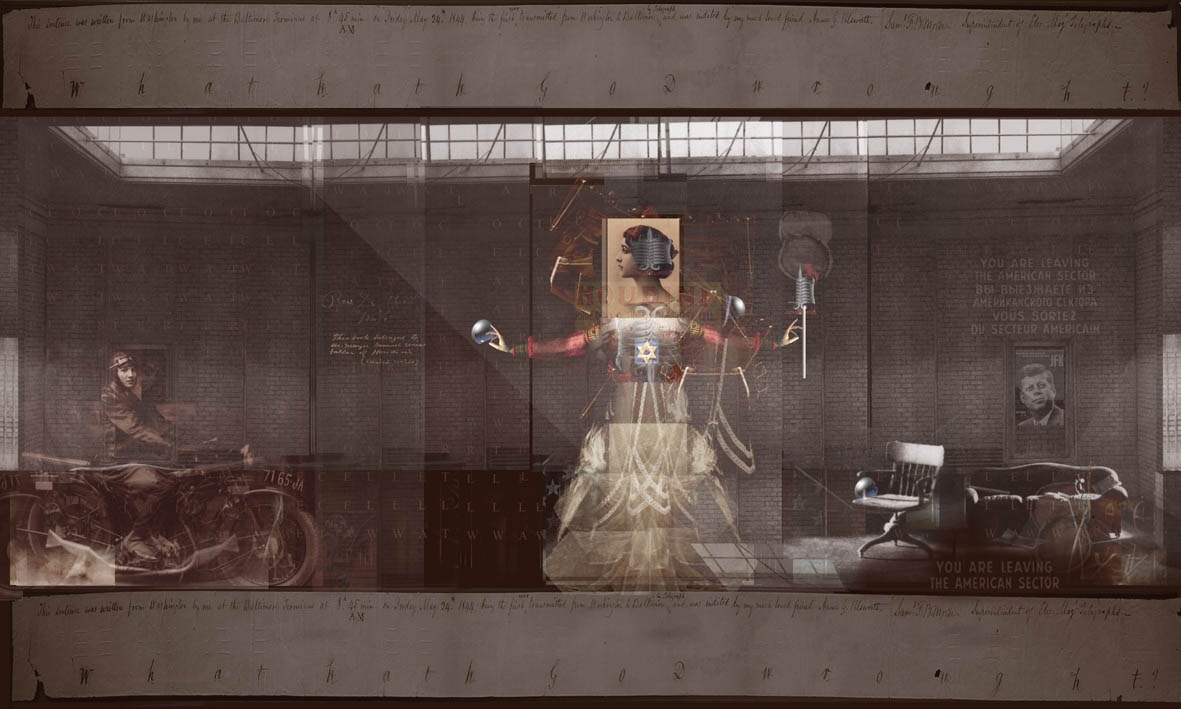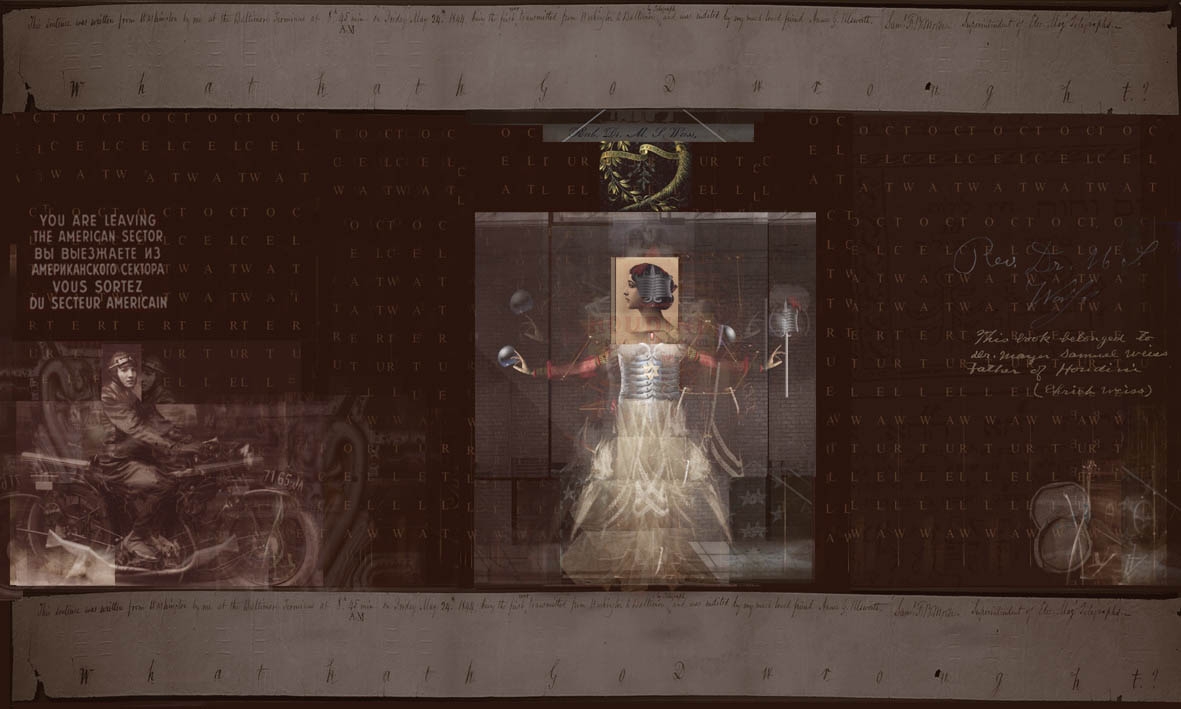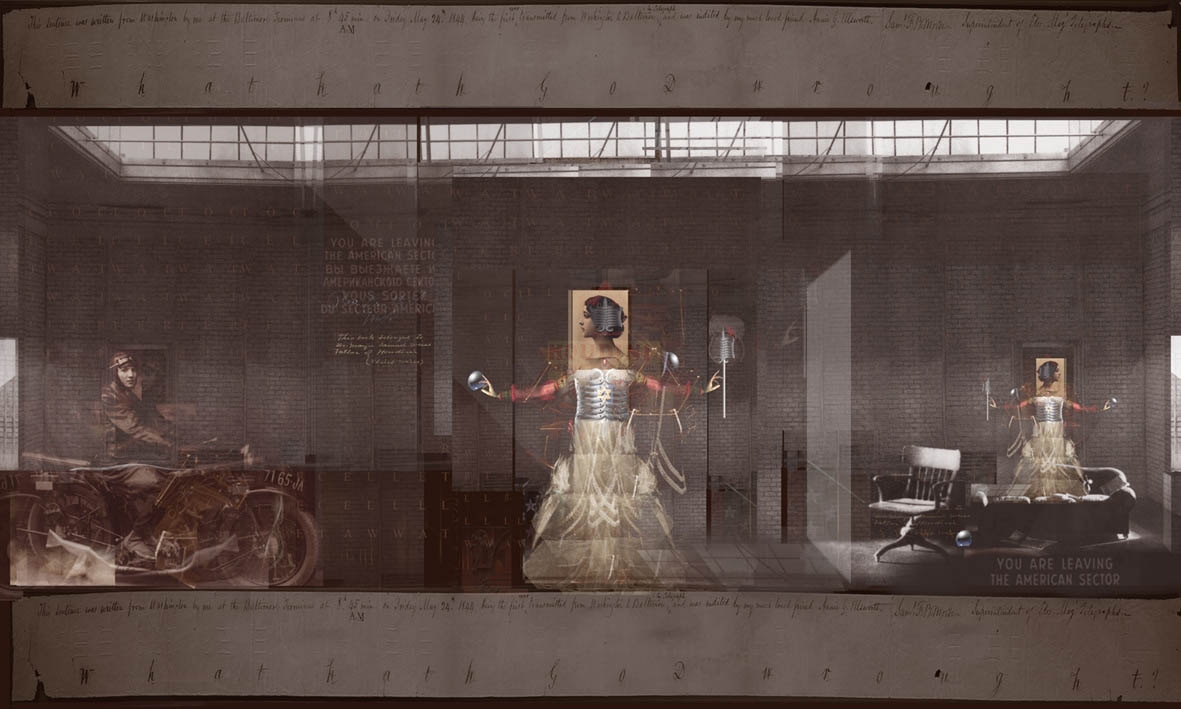| Horkay Istvan http://www.horkay.com
Some remark
The newest
Collages, Photo-Transformations of Horkay, in a
certain
regard are the
continuation of the previously established visual
formatting and
creating methods.
This are not
simple extract ions, or not only the
verifications of his
knowledge to
select from the wide tradition of visual art, but
a
selection for a
purpose. In the newest visual theory research
there
is a higher
emphasis on analyzing image anthropology (Hans
Belting).
Horkay's
artworks are directive by that respect. By giving
more
prominent value
to the expression of the implied anthropological
substance, to
the gesture, to the pose, he does not simply
create a
more significant
work as before, he implies those rudiments
(elements)
into his
statement.
The
anthropologists, and along them the contemporary
DADA is not
deterred from
the realization, that applying body language and
positioning in
the visual creativity process has tremendous
meaning
value.
That applies for
Horkay's art also. The power and expression of
his
work
comes from the
application and combination of the redemption of
the
meaning, and the
statement of gesture, pose and body.
Wolffin stated
already in 1921, that the vision has explanatory
and
illustrative
features, meaning we do not simply see, we see
something
by
something - by
that a vision is able to refer to not only
itself, but
to assign to a
certain relation trough it, which is more than
the
ordinary sight
itself, since we never see only the
picture.
A picture born
by a vision.
Bacsó Béla
Bela
Bacs and chair of Aesthetics at Eötvös Loránd
University in Budapest (Hungary).
He
has translated Heidegger, Gadamer, etc. into
Hungarian. His Hungarian language publications
include The Art of Understanding and
Understanding Art(1989);
Bos:
Hermecal Essays(1994); The Shadow of the Word:
Understanding Paul Celan's Poetry (1996),
"Because it is not know..."(1999),
Writing and Forgetting (2001), as well as a
colletion of essays in German, Die
Unvermeidbarkeit des Irrtums. Essays zur
Hermeneutik Junghans Cuxhaven-Dartford 1997.
Receblikations:
The Will to Truth in. Nietzsche, Epistemology and
Philosophy of Science.
Nietzsche
and the Sciences II. ed. Babette E.Babich Kluwer
Ac. P. 1999., and "Wille zur Wahrheit"
als Kunst der Interpretation in. Jd Wort ist ein
Vorurteil": Philologie und Philosophie in
Nietzsches Denken ed. Manfred Riedel Böhlau
Köln/War/Wien1999
http://www.horkay.com/essay-2.htm
THE
OVERPAINED WRITTING
by
Bela Bacso
"And yet,
word is not the life. People talk just to attack
something or to defend themselves.
But the one who
refuses talking...
How secretful a
picture is... A gleam...
that cannot be
explained."
Bram van Velde
Quite common is
when a painter traces the pictures of one-time
artists to learn from them, to crib their
secrets, to employ their knowledge for this own
picture making fantasy. It could be quite common;
but Horkay traces not Leonardo or Rubens, but a
text, namely the first handwritten page of
Freud’s Entwurf einer Psychologie
(1985), the mode how Freud’s hand was
writing, how he transformed the thought into a
tangle of signs and letters. On the write surface
(all-permitting and resistant at the same time)
the Freudian text appears as a kind of a culture
historical frottage – if I may use
this term in a somewhat figurative sense after
Max Ernst. The text does not mean simply itself;
it is hardly eligible. The meaning of the picture
is born from an "injury" to the tangle
of words. The never re-whitenable surface is
penetrated by colors; constancy is re-achieved,
since the retraced (frottage), and all written
artpiaces lose permanency with advancing time.
Horkay’s
art is epitomic in the double meaning of
the word: a fragment, an incised part of
something already in existence, and – just
because of this incision – is an injury to
the finished surface, to the tangle of writing or
a finished picture. This relies on the experience
that man, handing himself down through signs,
simulates a kind of sense-wholeness. In these
series this textual sense-wholeness appears to be
ever different as different colors enter the
surface at different sites. It is the same and
not the same at the same time. "Once the
signs are scars, then the wounds will tell tales
of some non-alleviated history" (D. Kamper
– Zur Soziologie der Imagination Hanser V.
1986. p. 148). The sign will temporarily closen
over the story. Who else would know this better
than Freud, who, after the
neurological-physiological and neuropsychical
phases, so deeply doubted that it was possible
"to bring to light the hidden content in its
wholeness" (Konstruktionen in der Analyse
1937. in: Stud. Ausgabe Ergb. Fischer V. 1982. p.
398).
This culture
historical "frottage" is an artistic
reminder of the liberating and deeply
doubt-evoking act of the Freudian turn, namely
that everything what gains sense in the sign is
not the movement of sense itself, but that of
alternating meanings, a re-determination of the
sign from the past history. The presence
of unclosed and non-fulfilled alternatives in
relation of the emerging sign is a pioneering
idea of the Freudian psychoanalysis.
"Interpretation comes fully untied in sense
relations, and will understand the force
relations (Verdragung, Wiederkehr des
Verdrangten) only through these sense relations
(Zensur, Entstellung, Verdichtung,
Verschiebung)." ) P. Riceur – Die
Psychoanalyse und die Kultur der Gegenwart in u.
o. Hermeneutik und Psychoanalyse. Der Konflikt
der Interpretationen II. Kosel V. 1974. p. 65).
Painting did
not, and naturally, could not withdraw itself
from this turn, be it termed "Beyond
Painting" by Max Ernst, or "die
Aesthetik des nichtrelationalen Bildes" by
the art historian G. Boehm. Beyond what, and
non-related to what: this is the principal and
unavoidable question of artistic painting in our
culture. Horkay’s pictures offer a rather
interesting answer to this. Embedded in the
artpiece, Federico da Montefeltro and Battista
Sforza, two figures of Piero della Francesca are
exposed to us as a well considered
"collage". In this delicious double
portrait of the Quattrocento the harmonically
arranged, perspectivic landscapes form the
background of man, in the foreplan of which man
is posted in a way that his rule is
unquestionable. The subdued nature expresses the
man "free in himself" as well as the
formidable maladjustment this glorified man has
to face when his attention is focused only on
himself, as it comes from the superior position
of possessing everything. This is expressed by A.
Chastel’s remark to Whipping of Christ,
a picture by Piero della Francesca: "He
augments both the arithmetical sense and the
intensity of colors to the utmost point, thereby
transforming Universe into a bright, unslotted
cage, where mankind can never lose its way."
(Chastel – Italian Art, Corvina 1973, p.
113).
The great late
modernists (Cezanne, Klee, Ernst, etc.) wanted to
break out from this well arranged and well
interpretated world, the prison of supposed
possessing of truth. The free-in-himself man, the
man making himself as the center, has re-presented
the world for himself in the monoperspective of
this all-self-reference. As worded by
Florenszkij: "Artistic truth has once and
forever disappeared from Western religious
painting – the process starting from the
Renaissance –, and though the painters
declared their closeness and fidelity to depicted
reality, in fact that had nothing common with the
true reality whose depiction they took the
liberty of, or formed a right to. (Florenszkij
– The Iconostas, Corvina, 1988, p. 30).
In Horkay, the
application of the painting historical element in
the picture is a remembrance of an era we are over;
over we are the naive relatedness created by
perspective, and over we are the picture creating
technique that relies on the latter. The
application is neither parodistic, nor is an
ironic citation, but is an emergence-transparence
of a pictorial element of a past era as an item
of a set. This set – writings, documents,
stamps, painted pictures, etc. – is not else
than some accumulated mass of culture and
knowledge that surrounds us as a fermenting and
evaporating hill of rubbish, of which everyone
tries to save something, as allowed by his own
fancy and the laceration and destruction degree
of the hill itself. The question is how in this
"post" era motion develops at all from
the radiating, energy-saturated set in our
cultural memory at the returning of the
displaced, the postponed, the passed and the
repressed. An experiment to create a
"scientific psychology", the
"Entwurf" is closing of an era, when,
naturally, the great ideas of the analytical age
are already in preparation. Derrida’s
criticism seems to be rightful: "If we start
from a hypothesis postulated in the Entwurf
twenty years ago, namely that a permanent trace
supposes that a road section (Bahnung) is
deliberated and some resistance is overcome, than
we have to conclude that there is no trace at
all, since there is no opposing resistance."
(Derrida – Die Postkarte II.
Brinkmann–Bose V. 1987. p. 107).
No kind of
memory will be born from the increase of
quantity, since on well-travelable, non-inhibited
road sections the latent time section is short,
and the content is manifested rapidly. We can
say, the conscience-fitness of perception is
uninhibited, that is, referring to the Wunderblock,
without permanent trace, it acts as a traceless,
non superscripted sheet of paper. As we know it
from Freud’s writings, memory is formed on
sites of permanent traces, and due to
discontinuous innervation, elements formed at
different times can be stored in the same
neuronal layer. Memory cannot be compared to a
laboratory settling system in which particles
ariving later will, by necessity, be positioned
in ever upper layers. Bahnung is not a
continuous-linear movement from the unconscious
through the preconscious to the conscious.
"Trace as memory is not a pure Bahnung
that could be acquired again and again in a
simple present. Trace is an ungraspable and
invisible difference among the Bahnungs.
(Derrida – Freud und der Schauplatz der
Schrift in u. o.: Die Schrift und die Differenz
Suhrkamp 1976, p. 308). Freud showed that delay,
postponing, supplementarity are inseparable from
life, while Derrida in this radical Freud
interpretations criticised the time to time
emerging naivity of transcription und
translation, and the belief that the mind would
be a motionless "text".
In his pictures
Horkay overpaints, incises the written signs of
the "Entwurf"; in other words, he tears
up the signs that close past history as
"scars". This is summoning of what
cannot be forced into signs. Painting becomes a
"chromatic language" (P. Kaufman)
which, now far away from the pure presence of the
self-exposing re-presented, presents the painting
to us as something "deferred", as it
was worded by M. Duchamp. Due to its time-giving
nature, delay is the eternal supplement to the
same thing, and thus it will never liquidate the
picture, but makes it infinite, resistant to any
intrusion.
The
"post-human" art of our era has moved
the farthest away from the ideal which reached
the calmness of total emptiness by putting
instincts to silence. (cf. Lyotard – Essays
zu einer affirmativen Aesthetik Merve V. 1982, p.
106). Opening the art toward the inherently
uncertain existence of man, toward the layers of
past history that cannot be covered by signs,
promises the possibility that man, on some
non-distincted place, will re-experience the
world as something of his own, where he will be
most essentially concerned by what surrounds him.
Then the artpiece will not serve to put to
silence "... what conceals itself, what
calls some self-concealing repulsion in man from
what can be neither planned or controlled, nor
calculated or performed." (Heidegger –
Die Herkunft der Kunst und die Bestimmung des
Denkens in u. o.: Denkerfahrungen Klostermann V.
1983. p. 148).
http://www.horkay.com/essay-1.htm
http://www.horkay.com/essay-2.htm
Kleist once
wrote: "The Poet would be happiest if he
could express
his Thoughts
without Words."
("What
an interesting Admission!" wrote Ludwig
Wittgenstein.)
"Horkay's
art is epitomic in the double meaning of the
word: a fragment, an incised part of something
already in existence, and - just because of this
incision - is an injury to the finished surface,
to the tangle of writing or a finished picture.
This relies on the experience that man, handing
himself down through signs, simulates a kind of
sense-wholeness. In these series this textual
sense-wholeness appears to be ever different as
different colors enter the surface at different
sites. It is the same and not the same at the
same time. "Once the signs are scars, then
the wounds will tell tales of some non-alleviated
history" (D. Kamper - Zur Soziologie der
Imagination Hanser V. 1986. p. 148).
The sign will
temporarily closen over the story. Who else would
know this better than Freud, who, after the
neurological-physiological and neuropsychical
phases, so deeply doubted that it was possible
"to bring to light the hidden content in its
wholeness"
(Konstruktionen
in der Analyse 1937. in: Stud. Ausgabe Ergb.
Fischer V. 1982. p. 398).
Bela Bacso
More
http://www.horkay.com/essay-1.htm
"Someone,
Somewhere" is how I title my Works,
thinking of the Free Individual, who Himself has
become the Center of the of Our Post Human Age,
the Focus of Our Collective Memory.
The Question is
How to give Visual Expression to that Memory, so
that the thus created Contents, can leave a
Lasting Impression.
An Idea or an
Image acquires a New Dimension as it is combined
with other Images.
Horkay
"would like his Works to be Visual Poetry
and Philosophy.
Artist's
Statement
Horkay's Museum
Factory series combines original drawn and
painted images, appropriated masterpieces,
photographs, artists' signatures and commercial
logos. These elements are digitally assembled,
i.e., collaged, to create a single, layered
moment reflecting different places and times.
This work is post pop, i.e., post modern pop art.
Whereas Warhol took moments from popular culture
and turned them into history, Horkay takes
history and turns it into a moment, as though the
past millennium was a monolithic unit of time.
More
http://www.lesliesacks.com/gallery/artistPages/horkay/horkay.htm
Horkay Istvan
In today’s
world, computers are used to simplify our lives.
However, as an artist, I find computers and the
digital world to be tools that must be taken
seriously, because they inherently reflect the
artist and his work. If my work is
considered in its mathematical and digital realm,
then we can see the duality of the human created
art and the binary basis of digitizing. It is of
the greatest importance that the humanity of the
artists reveals itself truly and is not
overshadowed by the technology. It is within
these considerations that I come to a dilemma
where I must find artistic parameters within the
unlimited power of technology. When my work is
saved as a psd file in Adobe Photoshop, I am at
liberty to change, alter, or rework my pieces at
will. My pieces, as stored files, remain alive
and not complete with the resoluteness of, for
example, a painting. Therein lies the
challenge of finding closure and the end point to
all the pieces.
While the technology poses challenges, I find my
expression in the limitless possibilities of
producing my art in any shape or size
allowable. Having this digital world as my
artist’s tools allows me to cross-reference
literature and poetry with imagery. It is within
the layering and the cross-referencing that the
artist’s character and soul emerge. To me,
each layer is another virtual poem laid upon
another one. My works contained hundreds of
layers, each seperate as it’s own poem, yet
each connect to all as a whole. My goal is create
a new genre of digital art, what I call
"virtual poems".
Horkay Istvan
|



